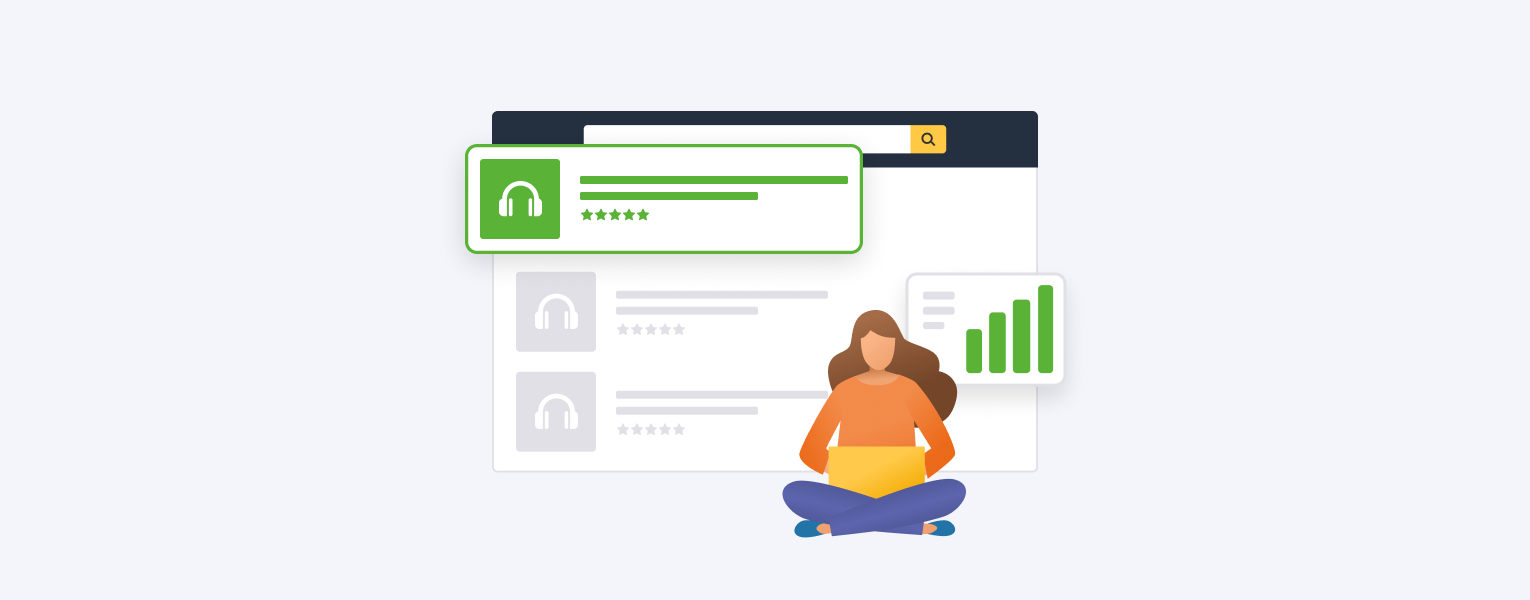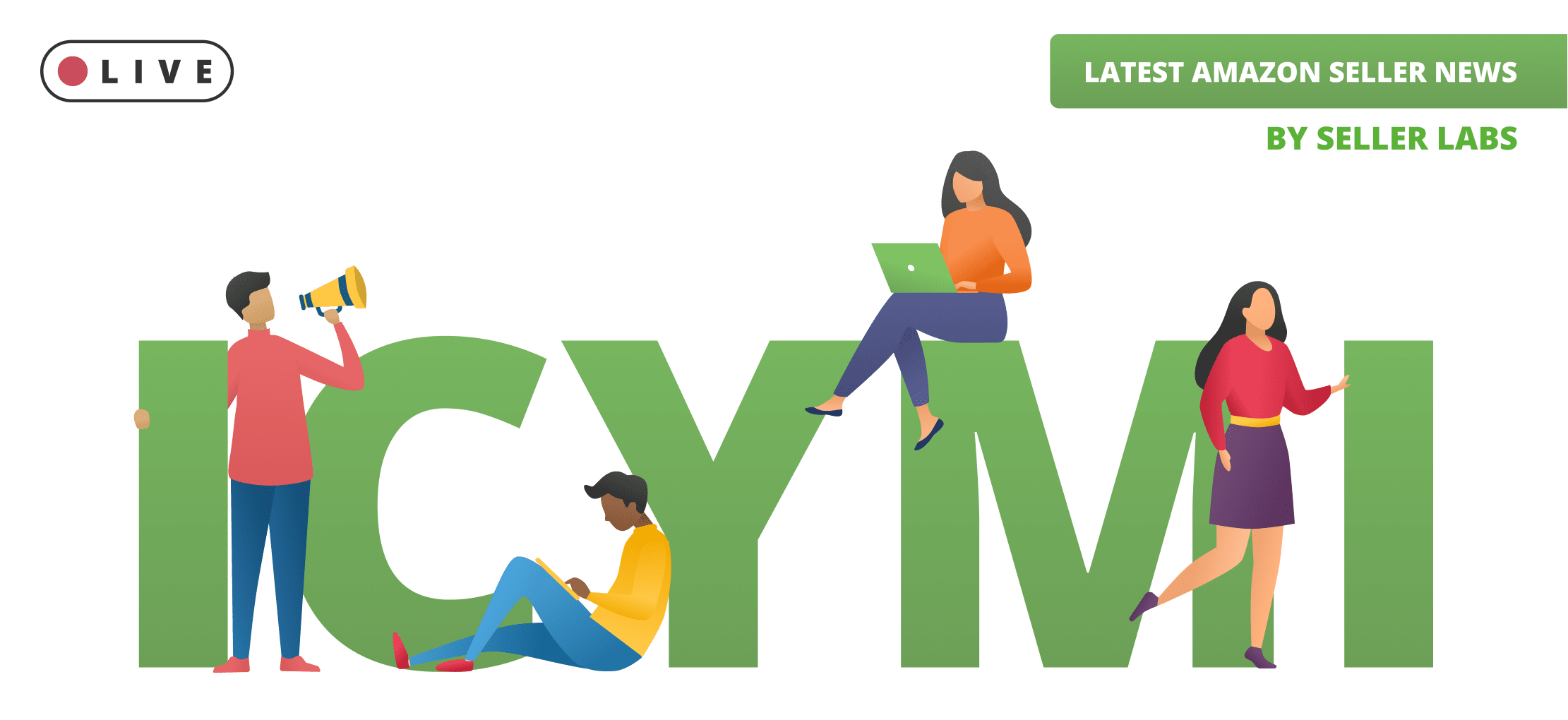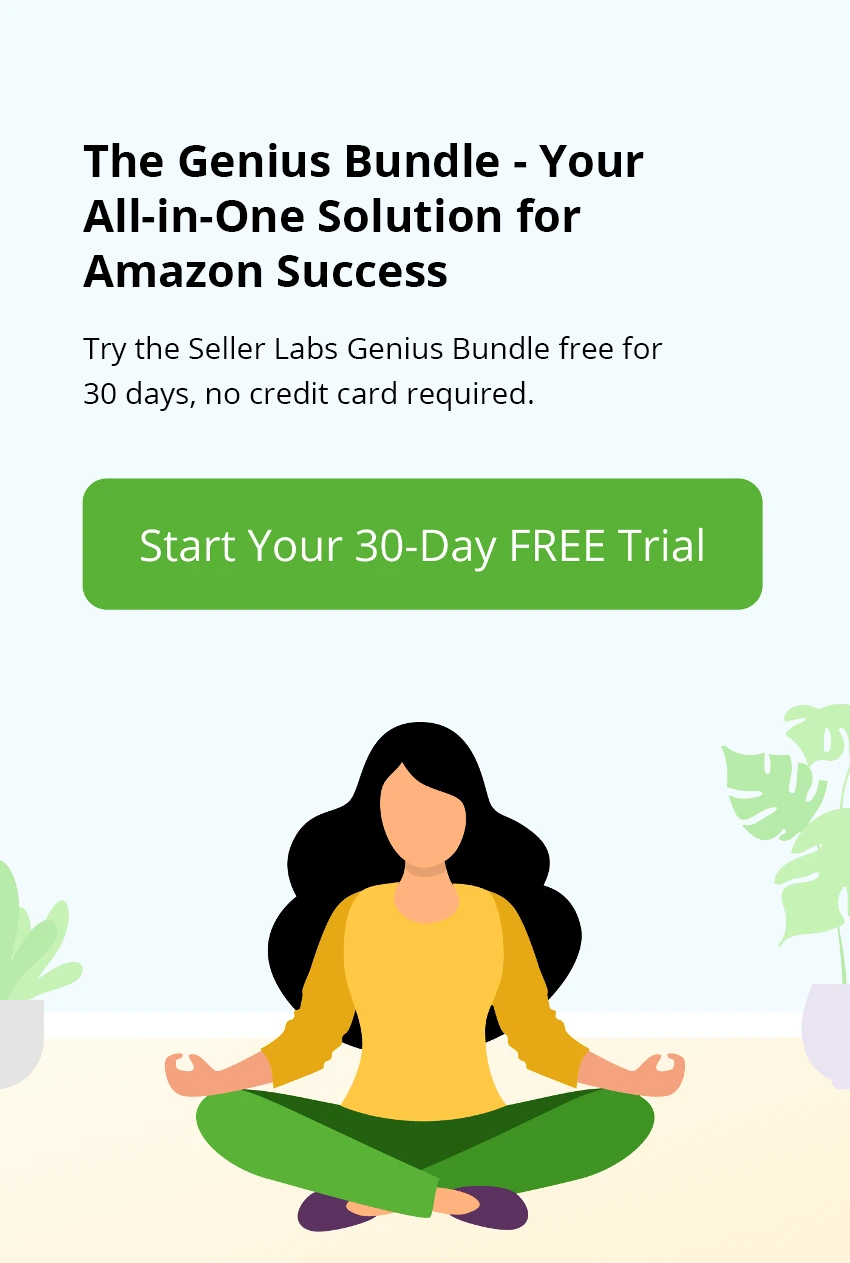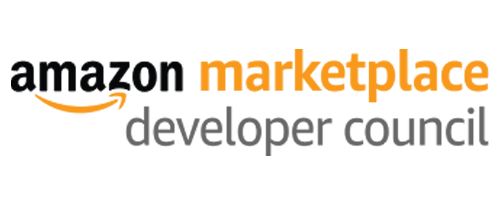So you want to become an Amazon Seller, eh?
If you are serious about becoming an Amazon seller, you’ve got to learn the Amazon flywheel. The Amazon flywheel is a growth strategy that helps you and the marketplace succeed – together.
Given all of the restrictions of the Amazon Marketplace, it’s easy to feel unwelcome, but let’s be honest; it is in Amazon’s best interests that you generate profits! After all, Amazon’s business model relies on your success.
TL;DR: Amazon wants you to succeed. Trust us.
To apply the flywheel to your business, you must learn that you and Amazon are in a lucrative partnership. In this how-to-sell-on Amazon guide, we’ll teach beginners how to work with, not against Amazon.
Here are all the parts of the flywheel effect that will help you sell on Amazon:
Introduction: The Amazon Flywheel
Wheel 1: Discovery
Wheel 2: Traffic
Wheel 3: Conversion
Wheel 4: Reviews
Conclusion: Continue Optimizing
But before we get ahead of ourselves, there are some basics to selling on Amazon for beginners.
3 Things Beginners Must Know to Sell on Amazon
1. Customer experience is everything.
You know this, but just take a moment to remind yourself. Amazon’s customer-centricity touches all parts of the business. When you keep customers buying more, Amazon will reward you.
2. Ranking depends on relevance and performance.
To learn more about this aspect of selling, read our complete guide on SEO for Amazon. Don’t have time for the 7-minute guide? Here’s the short of it:
Relevance
Relevance means your product is a good match for a user’s search.
Performance
Performance is determined by profitability and potential to sell.
3. Success begets success on Amazon.
Selling on Amazon is a virtuous cycle where success is rewarded with tools and privileges. These selling privileges further increase the likelihood of more success, and so on, and so on. Efficiencies of scale are Amazon’s jam. Help them sell more, and you’ll be their bread and butter.
On Amazon’s Side
Lower Costs→ Lower Prices→ Growth and Expansion→ New Programs→ Lower Costs … Repeat …
This business model relies on efficiencies of scale.
On the Seller
More Sales→ More Reviews→ Higher Rankings→ Better Placements→ More Sales … Repeat …
As a seller, more sales lead to more reviews and more profits for Amazon.
INTRODUCTION The Amazon Flywheel
Take a look at Jeff Bezos’ now-famous Amazon flywheel. When the flywheel is turning, success in one sphere builds momentum in the others. This is the optimal Amazon flywheel zone. (And it’s totally achievable for Amazon sellers who have great products.)
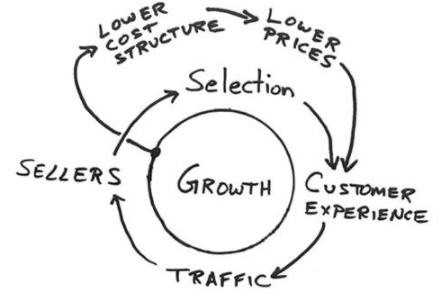
Sure, Amazon turns most of the gears, but the better you turn your gears, the more Amazon rewards you. The more Amazon rewards you, the more your business will grow.
There is no shortcut to applying the Amazon flywheel to your business. It takes time, but we’re here to help.
Now that you understand the big-picture, let’s explore the details of how to sell on Amazon for beginners. In the flywheel model, sales can be accelerated organically with great products, low prices, good reviews, and excellent customer service.
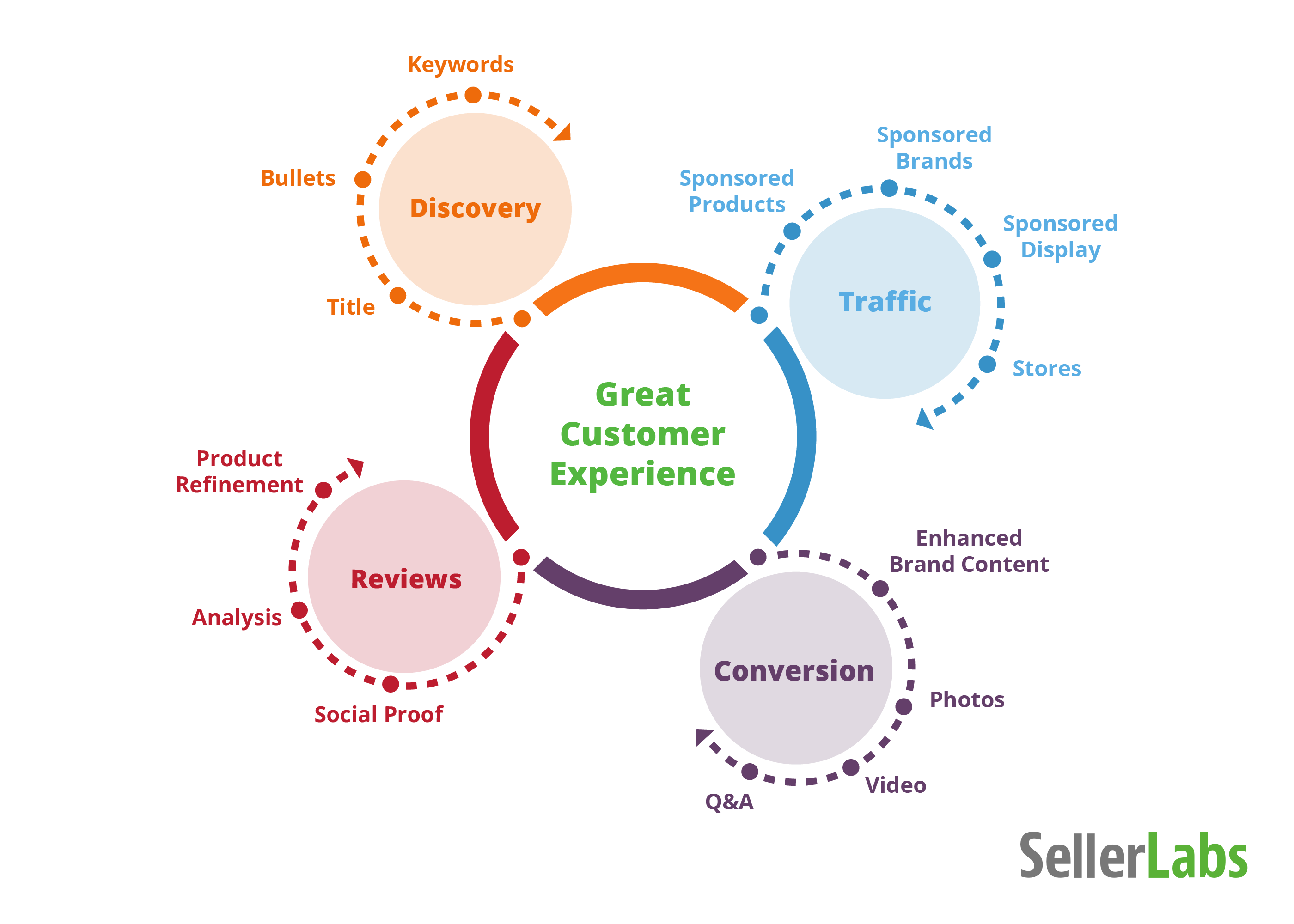
Above is a visual representation of the gears at work and how they turn. For each gear, we’ll provide information, tips, and resources to help you move the larger flywheel.
Want eCommerce tips delivered straight into your inbox? Sign up for our newsletter.
WHEEL I Discovery: Improve Amazon SEO
Simply put, discovery is about showing up in search results. Shoppers can’t buy what they can’t find. Help them find (and buy) your products with keywords.
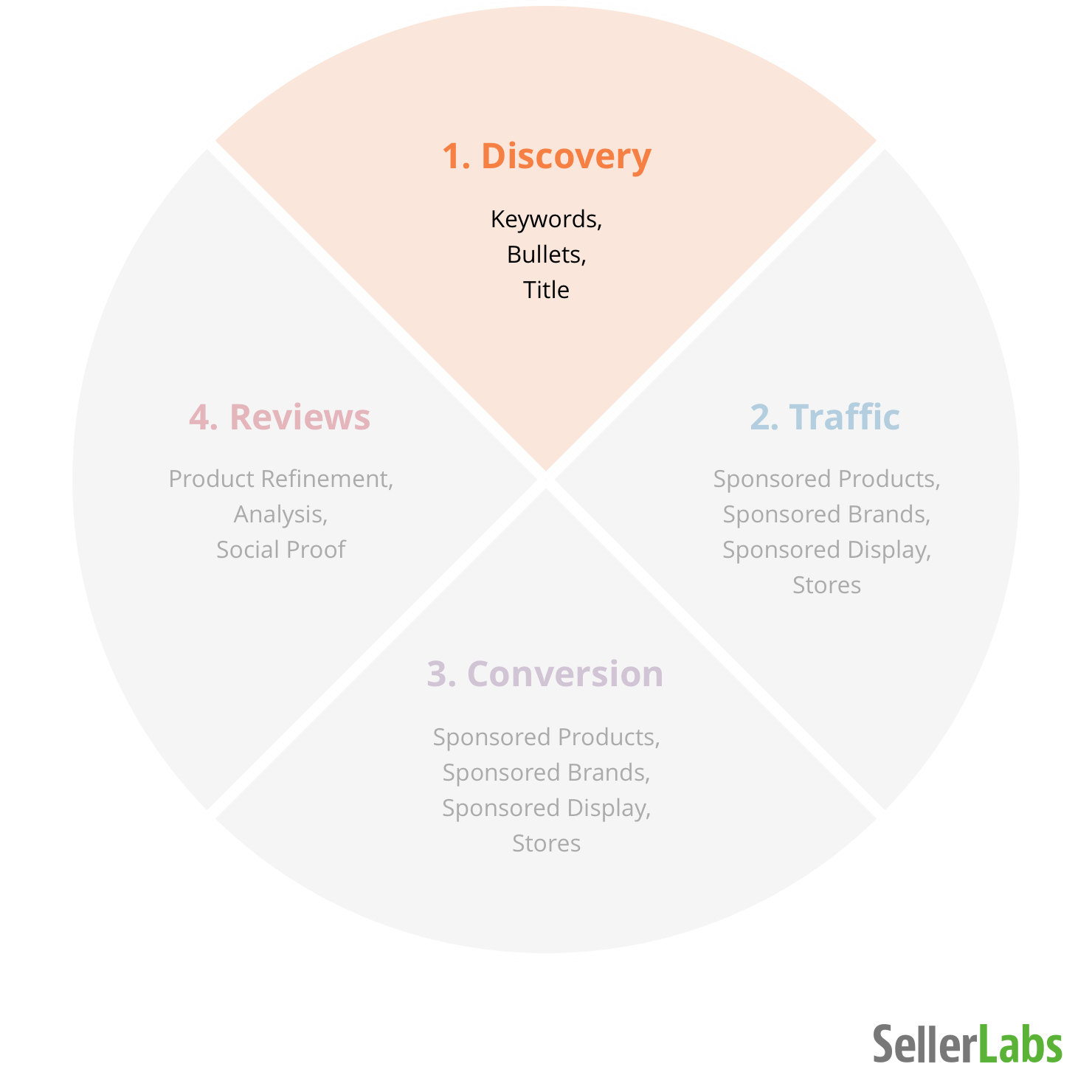
Keywords improve your rank in Amazon search results. To get better organic rankings, you need to learn about Amazon’s search algorithm.
TL;DR: If you provide listings that are complete, compelling, and packed with great keywords, you’ll get more conversions and sales.
What Are Keywords?
Keywords signify to Amazon’s algorithm which products match with user searches. The keywords you use in your product listing will determine how you rank on Amazon Search Engine Results Pages (SERPs).
How do you find keywords? Read our full article about choosing keywords for Amazon.
How do you choose keywords for Amazon? Replace “I think” and, “my gut says” with data-driven SEO research on Google & Amazon.
Maria NavolykinaWhere do you put keywords?
Gather your keywords, put them all in one list, and sort them by search volume and relevance. Put the most relevant & popular search terms for your product in the title, bullet points, product description, and backend keywords.
The Title:
The title is not only crucial to the Amazon algorithm, but it’s also the first thing shoppers read. You only have 200 characters for your title so use them wisely.
Remember that most shoppers are on mobile devices. Strike a balance between using your full 200 characters and appealing to users on a smaller mobile display.
The default title style to get you started is Brand + Model + Product Type + subsequent information such as material, purpose, size, quantity, color, etc. Read Amazon’s Product Title Requirements so that you can create the perfect title for your listing.
Bullet Points:
Because bullet points are “read” by both human shoppers and Amazon’s ranking algorithm, optimized bullets are non-negotable. Make all five bullet points easy to read and full of keywords.
Product Description:
The product description is where you are free to tell your story. It’s where you can express why your product is the best choice and do some reputation management for your brand.
Backend (Hidden) Keywords:
This is where you put the keywords that you want Amazon to see, but not shoppers. For example, if you sell affordable headphones, you want to appear in searches for “cheap headphones” but you don’t want to label your product as “cheap”. You’d put the word “cheap” in your backend keywords.
Here is some of what Amazon says regarding backend keywords:
| DO | DO NOT |
|---|---|
| Put keywords in the most logical order | Provide inaccurate, misleading, or irrelevant information |
| Use a single space to separate keywords. No commas or other punctuation | Include statements that are only temporarily true (“new” or “on-sale”) |
| Include abbreviations, alternate titles, topics/subjects, and key characters (for books, movies, etc.) | Include subjective claims such as “best” or mention competitors or their brand names. |
| Use keywords that are synonyms, hypernyms, or spelling variations (e.g. if product title is ‘whiskey’, use ‘whisky‘ in the backend keywords). | Include keywords variations that already appear in the listing, like upper and lowercase, or plural and singular keywords. |
Remember, Amazon indexes only the first 249 bytes in backend keywords, so you have to be sparing.
Don’t Forget the Details of Selling on Amazon
Both shoppers and Amazon respond well to listings that are complete. What do we mean by complete?
- The listing gives buyers the extra information that may make them more likely to choose your product over your competitor’s.
- The listing provides information so that buyers know exactly what they are getting. The result: fewer returns.
- The keywords send a signal to Amazon to match your product to a customer’s search.
We get it; writing such a quality listing takes time, energy, and effort. Our listing optimization experts are here to help, but if you’re the DIY type, try to optimize your time as well as your keywords.
Time Saver
Unlike Google, Amazon doesn’t care about original content. This means that if you have an awesome keyword-dense product description on your own site or another commerce site or anywhere else, you can use it as-is on Amazon. So make that easy on yourself with some copy-paste-adjust treatments of existing listings.
Time Taker (But Well Worth It)
Remember that Amazon is asking sellers to provide structured listings written in keeping with its guidelines. Follow the instructions, respect the rules and parameters, and complete every applicable field. Taking the time to thoughtfully complete as many detailed fields as possible is a win for you, buyers, and Amazon.
But Wait, There’s More!
We almost forgot – there are many fields in addition to the title, bullets, product description, and backend keywords. These pesky details may seem like a waste of time, but they are actually opportunities to rank better and sell smarter.
Filling out these fields all the way makes your product filter-friendly in the left sidebar. Not only will this help you users find your product when browsing, but it will also tell searchers that your product is the best match in terms of color, size, brand, Prime eligibility, etc.
Below are some of the fields where providing information (that is thorough and correct) is essential.
Manufacturer Part Number (MPN):
When a shopper is looking for something specific, such as a replacement part, the Manufacturer’s Part Number is crucial. A specialty light bulb, a replacement heating element for an oven … these are the sorts of things where shoppers rely on unique identifiers to make sure that they are getting the exact part they need.
Be sure to not only add your MPN (if applicable) but to double-check to make sure you’ve got it listed correctly and have included other products with which it is compatible.
Specifications:
Don’t skimp on specs. Sure it seems like hyper-specific technical info, but it matters, and not just to gear geeks browsing electronics. Specs like size dimensions, weight, color, power output, software version, etc. are what will differentiate your product from others, and prevent returns.
Category and Subcategory:
Although search is the most-used method for finding products, we can’t ignore that shoppers browse. This is where the category and the subcategory are important. Be sure to select these carefully and to drill down as narrowly as possible so that you are competing with fewer other products in that classification. Learn more about Amazon’s Browse Tree Guides (BTG) so you can increase your product’s discoverability for browsing.
If this is your first product, we recorded a video on how to list your product on Amazon.
Sound Like Too Much Work? Emails?
Seller Labs’ tools and services help you dominate Amazon SEO. Maximize your product visibility, not your workload.
WHEEL II Traffic: Start Amazon PPC
When we say traffic, I more mean eyeballs on your product, plain and simple. We’re taking a shopper from having found your product to clicking on your listing.
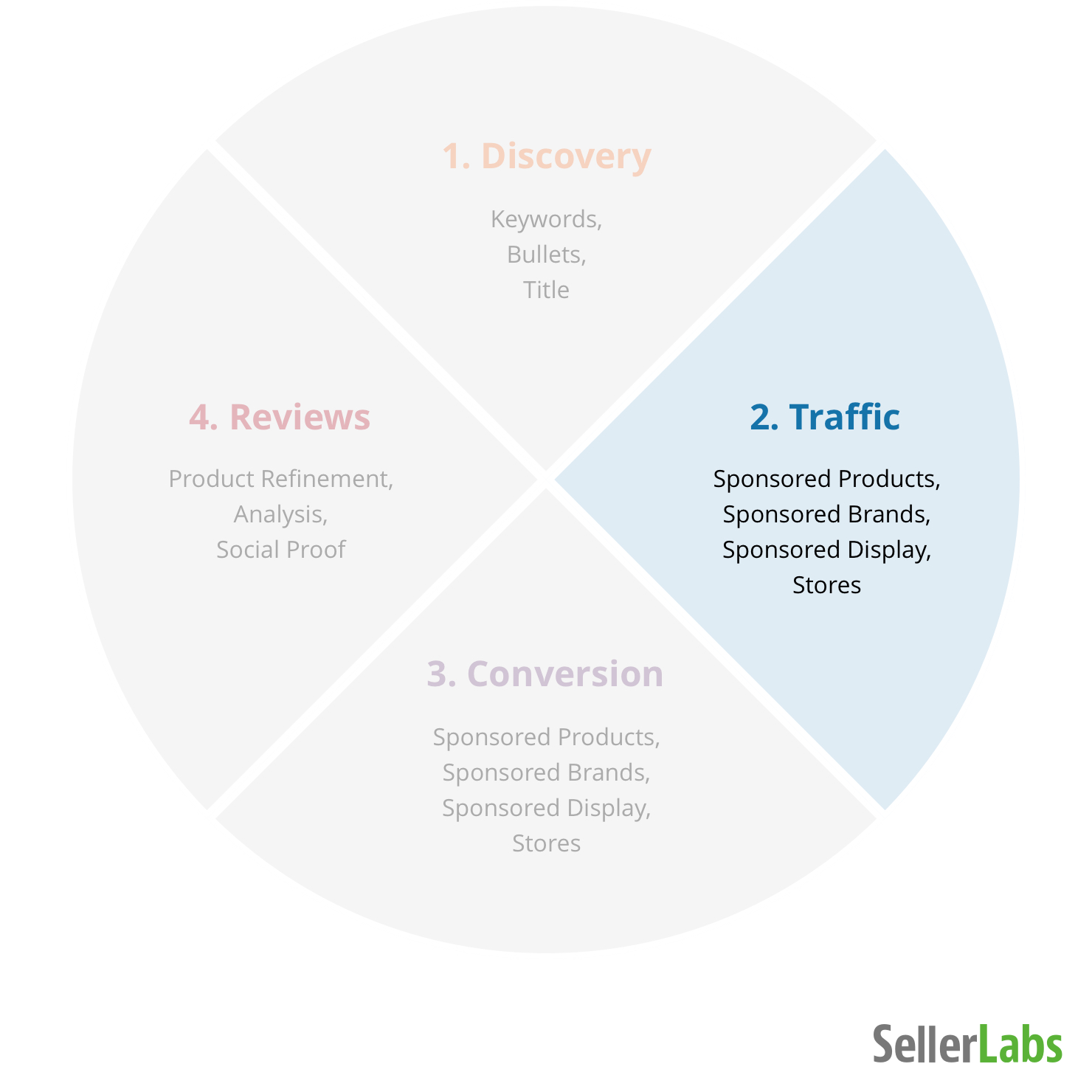
How do you cross that bridge from impression to click? Advertising.
When you advertise on Amazon, you need to take calculated risks and monitor your reports. Consider the many Amazon Pay-Per-Click (PPC) Advertising options available:
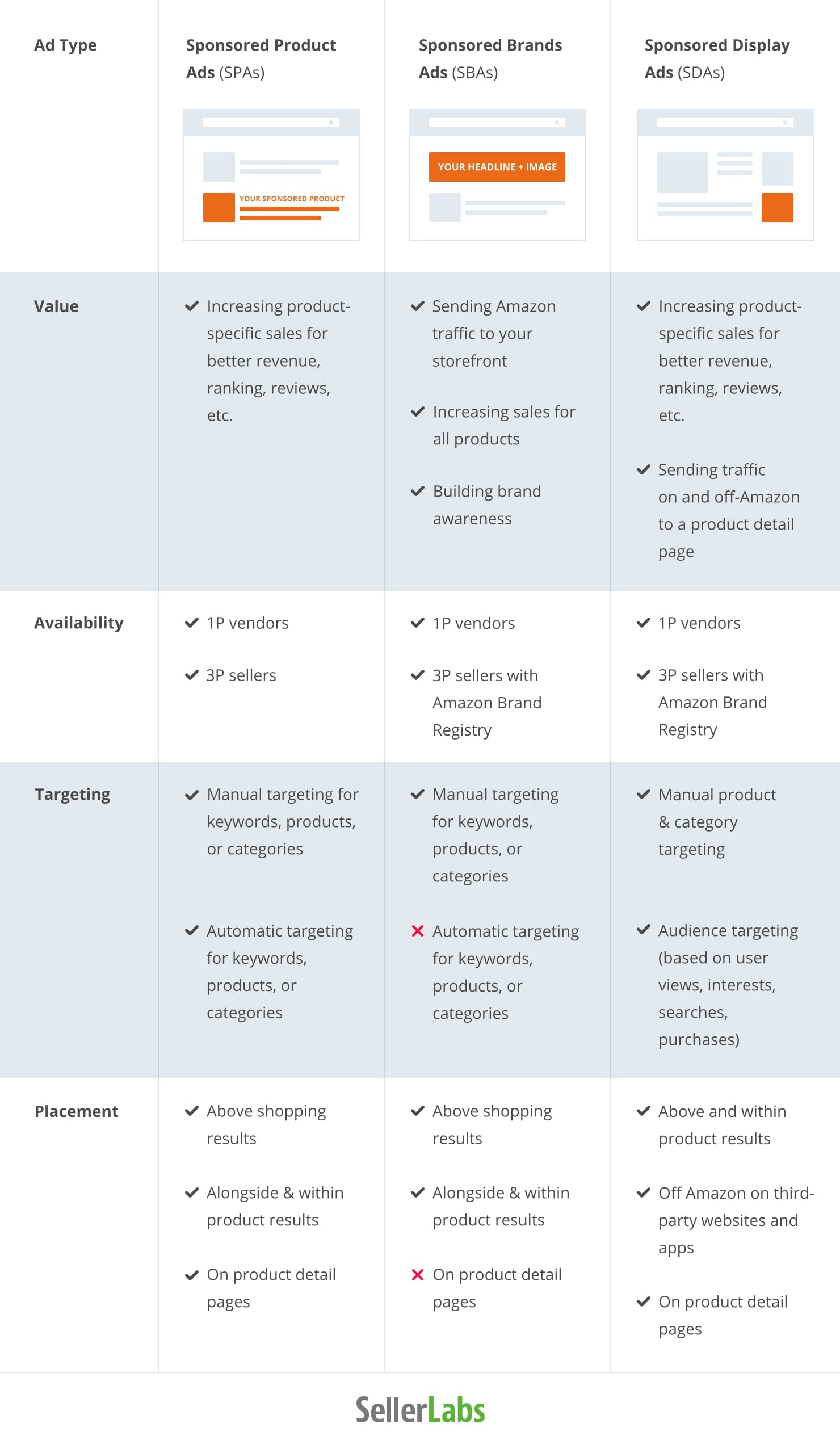
Not every type of ad is the best fit for every product or brand. But if you w listen to what the data says, you can absolutely turn lackluster product performance into best-seller status. Start by reading The 4 Cornerstones of How to Advertise Effectively.
Other Methods of Advertising:
The next two gears are all about sealing the deal. With discovery and traffic, you’ve got a potential buyer on your detail page. Now, you need to convince that buyer to add your product to their cart, check out, and leave a review.
WHEEL III Conversions: Make Sales on Amazon
Completing sales is the most important part of the sellers’ flywheel. On Amazon, a high conversion rate gets rewarded with a better ranking, which further increases the likelihood of subsequent sales.
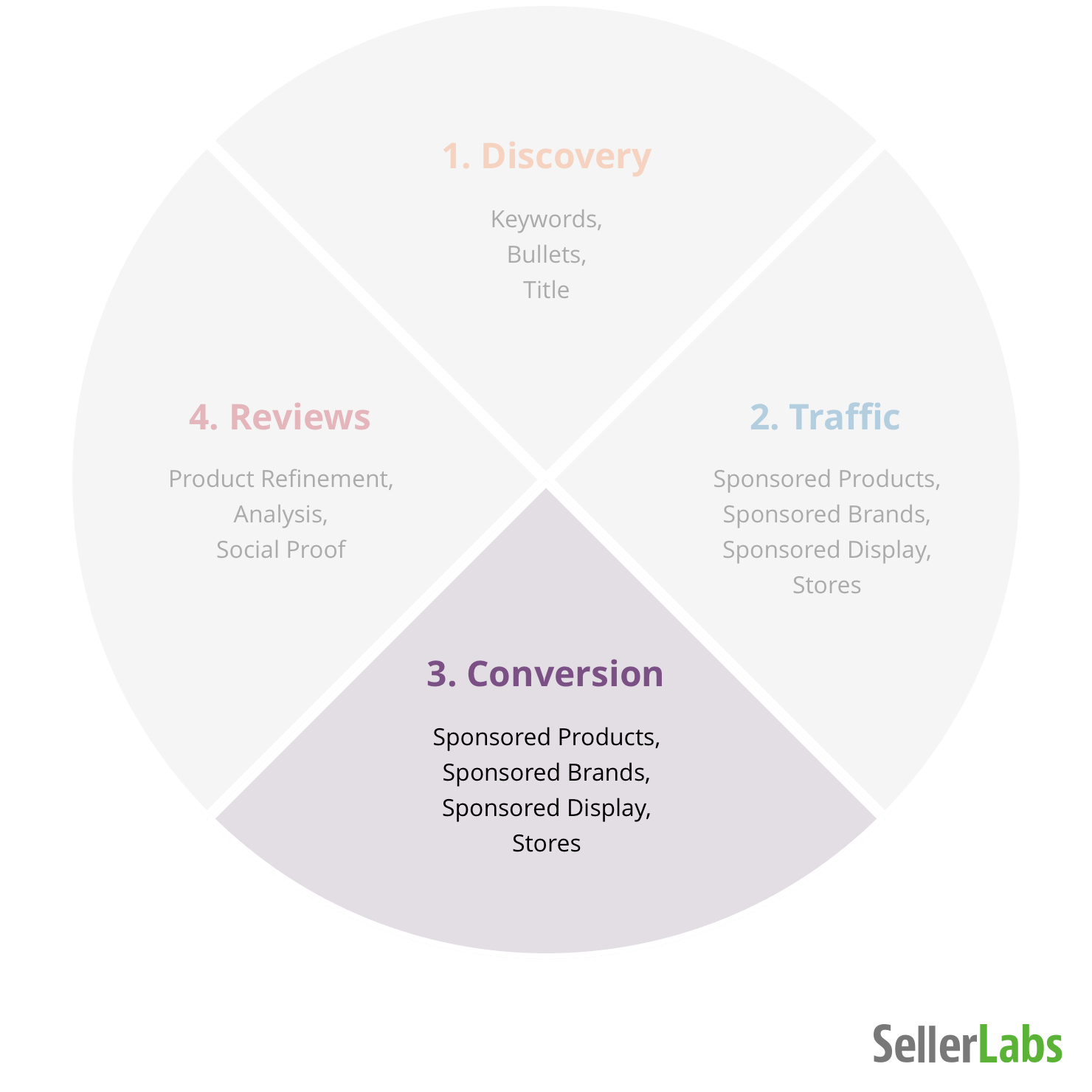
You can do a lot to increase your conversion rate, but first, what is a conversion rate?
TL;DR: Conversion rate is measured by the total number of sales divided by the number of unique page visits. text

Total Order Items: Total number of order items ordered for the selected time period. (Note: An order can have multiple order items, and each order item can have multiple units.)
Sessions: Number of unique visits to your Amazon product detail page within a 24-hour period. (Note: A user might view your pages many times on a single visit, resulting in a higher number of page views than sessions in your reports.)
How To Increase Your Conversion Rate on Amazon
The best way to optimize for conversion rates is to increase your sales. The following factors influence whether or not a customer buys a product:
- Cost Structure
- A+ Content
- Images
- Fulfillment by Amazon
- Badges/Endorsements
- Promotions
Optimize Your Cost Structure (Get Lower Prices)
Price is the most important factor determining which seller owns the Buy Box. Win this crucial real estate, and get the bounty of conversions that the Buy Box delivers.
Shoppers are going to choose the item priced lowest. Sellers want to have the lowest price in order to capture the sale, but the price can’t go so low that there’s no profit in selling the product.
So how do you play the price game with your competitors without accelerating the race to the bottom?
- Set a price threshold and don’t cross it.
- Do your best at cutting costs before you get to Amazon. If you optimize in areas like sourcing and manufacturing and packaging and shipping, you can be more flexible in pricing
Design Stellar A+ Content
Learn how Amazon A+ Content allows brand owners to customize listings with images and stand out in a crowded marketplace.
Maria NavolykinaThe best way to write killer content, without a web designer? A+ Content. A+ Content’s templates don’t just beautify product detail pages, they allow you to tell the story behind your brand.
These content-rich pages leave standard pages in the dust. Plus, a page that is super-robust implies a professional seller who is invested in customer service.
Pro-Tip: Before digging into A+ Content, get a handle on the fundamentals. Remember that you can do a lot with simple HTML, quality images, and great copy.
Need-to-knows when deciding whether or not to use A+ Content:
- Amazon doesn’t index A+ content. This content is not intended for Amazon SEO, so it’s not going to help your discoverability. The goal of these pages is to create a more visually compelling product detail page, which helps your conversions.
- You need to be a member of Amazon Brand Registry, in order to use A+ Content.
- While A+ Content is awesome, it requires approval from Amazon, which puts you at risk for having your hard work rejected.
Upload More (or Better) Images
Images are hugely influential. Use as many of the available image slots as you need to convey selling points and information about your products. You technically get nine images per listing, but only seven are usually displayed.
To be safe, stick to seven images and designate one large primary image with up to six alternate/secondary images. Don’t just use snaps of your product from various angles. Lifestyle shots of people using your product speak volumes.
Image Guidelines from Amazon
- Images must accurately represent the product and show only the product that is for sale.
- The product and all its features must be clearly visible.
- Main images should have a pure white background.
- Main images must be professional photographs of the actual product (graphics, illustrations, mockups, or placeholders are not allowed).
- Images must match the product title.
- Amazon accepts JPEG (.jpg), TIFF (.tif) or GIF (.gif) file formats, but JPEG is preferred.
- Even more image specifics here.
Image Tips from Seller Labs
- Clean up your pics in photo-editing software (but do not alter the product depiction).
- Watch out for shadows, reflections, and background elements that might be captured.
- Make sure that the product occupies at least 85% of the image area.
- Show the product in use so you can convey its value to the user.
- If your brand is on the product, capture that in a photo.
- Snap close-ups of important/differentiating features.
- Include pictures of product packaging, including accessories
A few key takeaways regarding images on Amazon product detail pages:
- Don’t be afraid to spend a little money on a professional photographer.
- Amazon measures the user’s time on a page, and longer duration is better. More pictures zoomable pictures that show important details make for longer visits.
- Follow Amazon’s rules. Submitting pictures that are not in line with Amazon’s guidelines will result in Amazon suppressing your listing.
Create a Killer Product Video
Here are five ideas for your first video on Amazon listings, and how to film it without breaking your budget.
Maria NavolykinaVideo is available to active professional-level sellers who are in good standing and Brand Registered. Video content must be approved by Amazon and there are strict video guidelines.
Before you take on creating and adding videos to your Amazon product listings, carefully read your options for creating product videos.
Get Badges and Endorsements
Good sellers get rewarded with endorsements like “Amazon’s Choice” and ”Best Seller”, both of which carry a lot of weight. These badges not only inspire trust but also signify that the product is well-liked.
Register for Fulfillment by Amazon (FBA)
An Amazon FBA Business isn’t what it used to be. Learn the basics of Fulfilled by Amazon, but don’t forget to expand your selling options.
Maria NavolykinaWhen you use FBA, you get “Fulfillment by Amazon” on your detail page as well as the Prime checkmark icon – that’s a gamechanger.
Prime means fast, free shipping from an Amazon fulfillment center. Customers are more confident with products that carry the FBA name, which does wonders for conversion rates.
Extra bonus: because Amazon is invested in FBA products, they get a bump up in terms of Amazon rankings.
Offer Promotions
Run Promotions well and you’ll sell more and faster. Beware, do promos the wrong way, and you’ll lose a lot of stock and money. Start with short-run offers so you can get a sense of the response and any correct mistakes you make.
And when you do go live with a promo, test it immediately and edit as needed. Otherwise, you could find yourself literally giving products away, thanks to an unlimited claim code that went viral.
Aside from the obvious options available in your seller account, we recommend trying these tactics.
- For tiered money-off promos, create stackable offers that will apply in increasing order. For example, buy 5 items and get $5 off, and buy 10 items and get $10 off.
- Try BOGO promos where instead of getting a second of the same product free or at a lesser price, you attach a different item for the freebie or discount. If enough buyers partake, you’ll find yourself with those two products linked and suggested in the Frequently Bought Together section.
- Create a Sale: Technically not a promotion, you can create a sale using the FBA Inventory Age report and Amazon will recommend a price point that should help you sell more (you can also just lower the price but Amazon gives no recommendation in that case).
Maintain Good Seller Performance
Pro-Tip: Everything that you need to know about your standing in Amazon can be found in your Account Health (under the Performance tab) and Business Reports (under Reports).
Account Health and seller performance metrics include, but are not limited to, orders, sales, defects, sessions, returns, cancellations, stock-outs, etc. Make it a habit of checking your Account Health and Business Report daily.
For additional insights delivered in a clear, helpful manner, try Seller Labs PRO. The PRO dashboard will keep you up to date with insights so that you can make better business decisions.
WHEEL IV Reviews: Get Better Feedback
What buyers (especially buyers who have made verified purchases) say about your products matters more, than anything you can say about it. Good product reviews are a must for all third-party sellers.
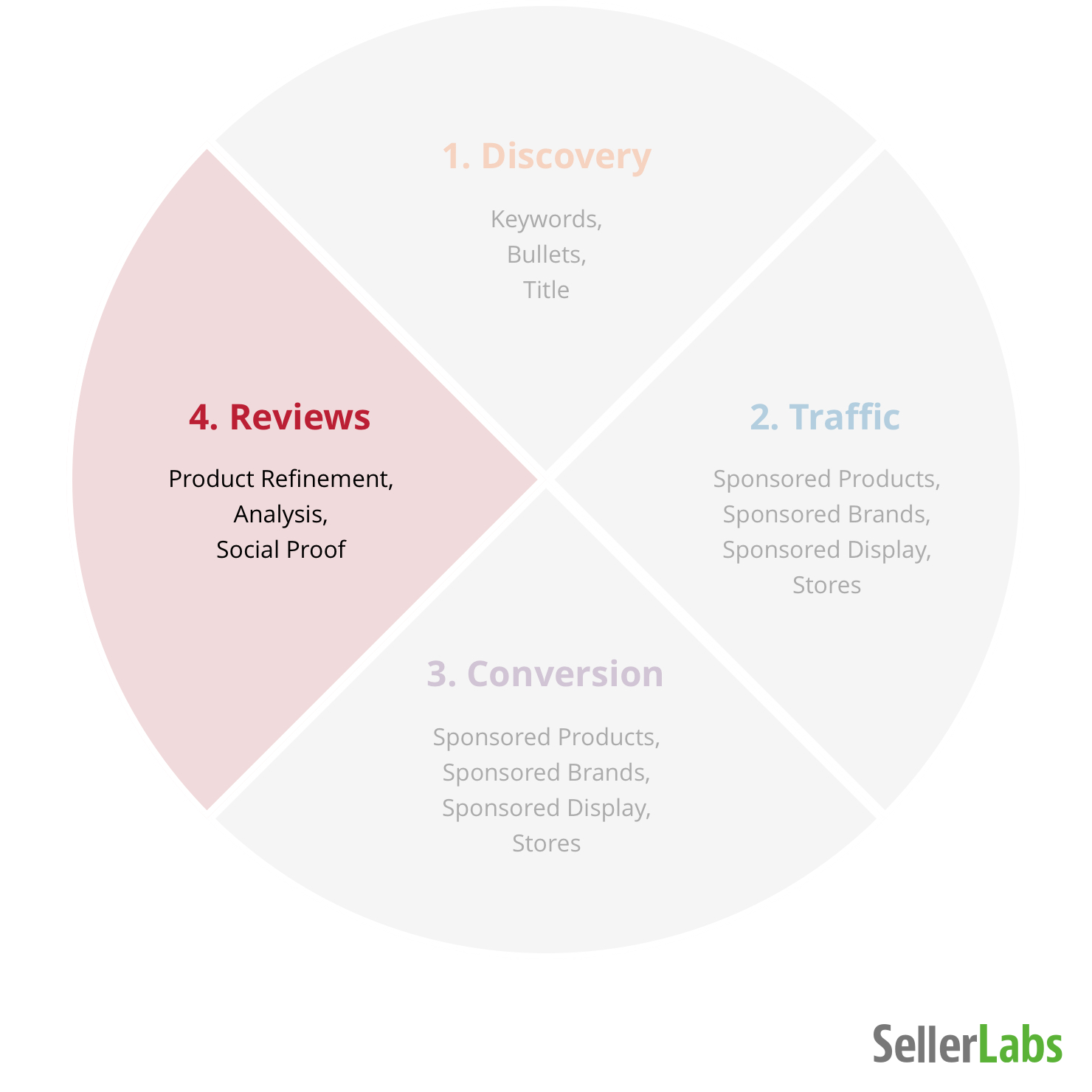
Customer opinions will significantly help your conversions and your rankings. Reviews are the most crucial gear that propels your portion of the Amazon flywheel. You need to master how to get more reviews on Amazon and improve your Amazon seller feedback.
Pro-Tip: Don’t disregard your competitors’ reviews; those can provide you with valuable information about what shoppers care about.
Don’t take chances on customers leaving you feedback and reviews. There’s a difference between seller feedback and product reviews. Follow up with buyers methodically and respectfully using a tool such as Seller Labs PRO.
- Use a communications tool like Seller Labs to master the buyer-seller relationship. A good tool will do the following: Check-in with buyers after they’ve made their purchases.
- Guide buyers about where to leave a product review and where to leave a seller rating.
- Ask questions that will help you discover ways to become an even better seller.
- Address buyer concerns and make the appropriate changes to your listings and processes.
- Offer buyers more value by including usage guides and instructions or other supplemental resources.
Subscribe to our newsletter to receive more Amazon tips, news, and best practices.
CONCLUSION Turn the Gears to Profits
Let’s reconnect with Amazon’s foundation: customers first, always. Remember that you are an Amazon seller, and thus an extension of the Amazon brand. Everything on Amazon is about providing a great customer experience.
When you as a seller provide an awesome product at an excellent price, you will be rewarded with good seller feedback and product reviews. Once you start turning the flywheel, they’ll keep running.
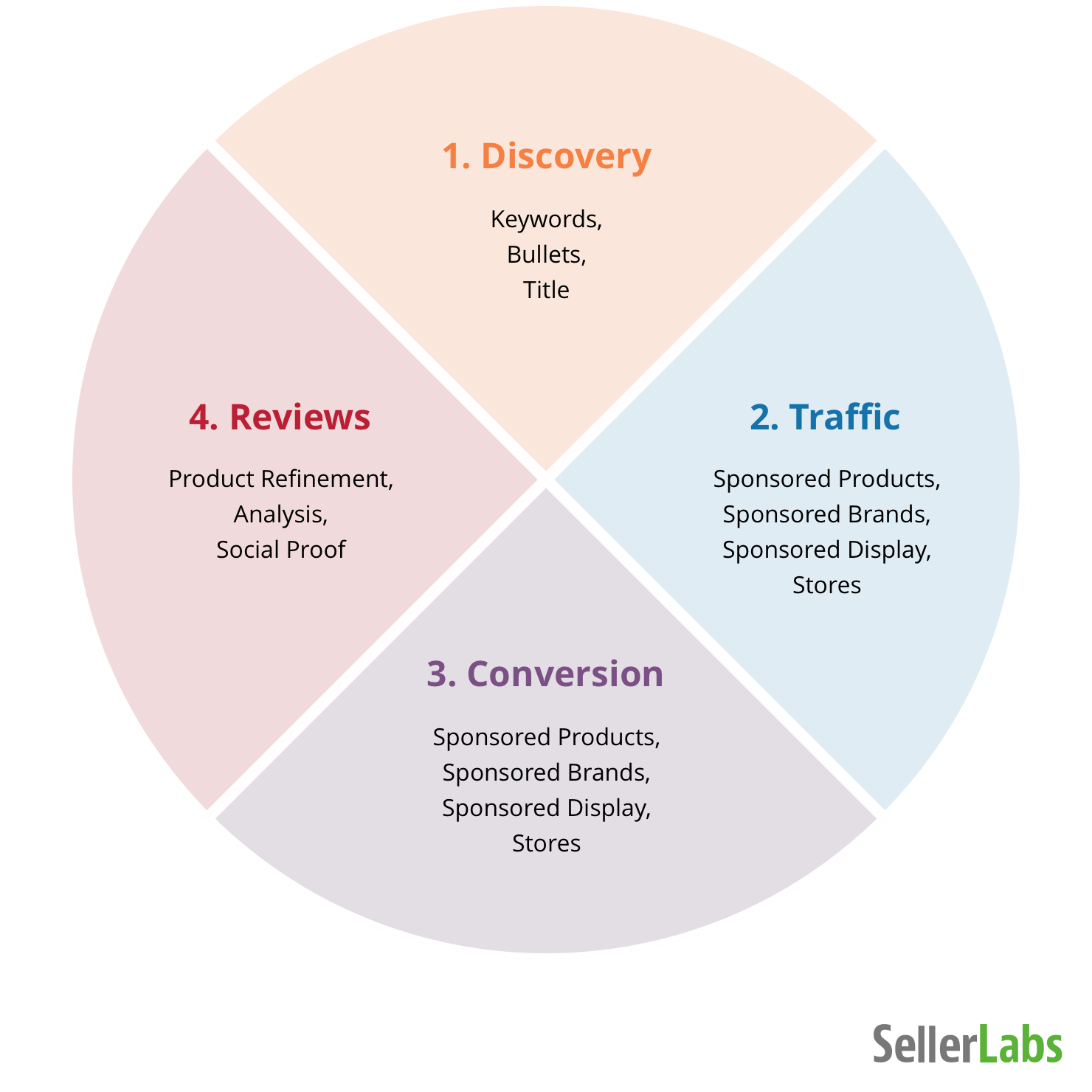
This being eCommerce, however, don’t think you can put the flywheel on autopilot. How many times have we heard of Amazon changing its algorithm? That said, here are some pivotal points that never change.
How to Sell on Amazon: The Beginnings of Success
- Amazon’s success and sellers’ success are intertwined.
- The customer experience is everything.
- Discovery is about ranking your product listing well in Amazon search results. Fill out as much of your listing as possible with keyword-rich copy.
- Traffic is about getting shoppers to your product detail page. Jumpstart this process with paid ads.
- Conversion is about turning a shopper into a buyer. Get more conversions by optimizing your price, images, copy, video, badges, promotions, etc.
- Reviews are a must to sell on Amazon. The best way to avoid negative reviews and ratings is to deliver a great product and great service. There are no shortcuts.
And that’s all there is to it. Sound like a lot of work? Well, it is, but we’re here to help.
Ready to Manage Your Business the New Way?
Seller Labs PRO will build a tailored Amazon strategy that works for your business.

